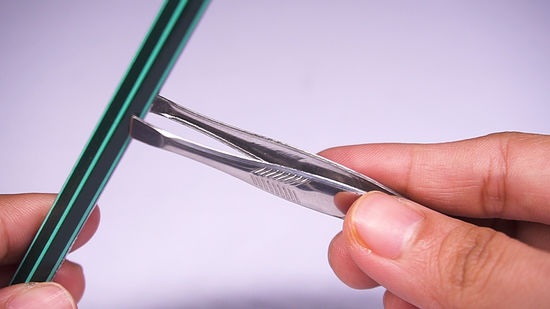Introduction
Tweezers are a versatile tool used for a variety of tasks, from plucking stray hairs to picking up small objects. However, over time, even the sharpest tweezers can become dull and lose their effectiveness. Fortunately, sharpening tweezers is a simple process that can be done at home with a few basic tools. In this comprehensive guide, we’ll walk you through the steps to sharpen your tweezers and keep them in top condition.
Why Sharpen Tweezers?
There are several reasons why you might want to sharpen your tweezers:
- Improved grip: As tweezers become dull, they lose their ability to grip small objects or hairs firmly. Sharpening them restores their gripping power.
- Easier use: Dull tweezers require more effort to use, which can be frustrating and time-consuming. Sharpening them makes them easier to use and more efficient.
- Longer lifespan: Regularly sharpening your tweezers can extend their lifespan, saving you money in the long run.
Tools Needed for Sharpening Tweezers
To sharpen your tweezers, you’ll need the following tools:
- Nail file or sandpaper: This primary tool is your key to removing the bluntness from your tweezers’ tips and restoring their sharp edge.
- Leather strop: A leather strop is used to refine and polish the edges of your tweezers after sharpening.
- Ceramic sharpening rod: This tool is used to realign and straighten the tips of your tweezers.
Gathering these tools and materials sets the stage for successful tweezer sharpening, allowing you to optimize their performance for various tasks.
Preparing the Tweezers
Before you embark on the process of sharpening your tweezers, it’s vital to ensure they are properly prepared. This step lays the foundation for a successful sharpening process and optimal results:
- Thorough Cleaning: Begin by thoroughly cleaning your tweezers. Remove any dust, debris, or residue that might have accumulated on the tips or along the edges. A clean surface ensures that you’re working on the actual metal, allowing for effective sharpening.
- Inspection: Take a moment to inspect your tweezers closely. Look for any signs of damage, such as nicks, bends, or misalignments. Addressing these issues before sharpening will contribute to a smoother and more precise process.
- Remove Moisture: Ensure that your tweezers are completely dry before you start sharpening. Any moisture or dampness can affect the sharpening process and potentially lead to corrosion. Use a clean, dry cloth to wipe them down if necessary.
By adhering to these preparatory steps, you’re setting the stage for a successful tweezers sharpening experience. Clean, well-inspected tweezers ensure that the sharpening techniques you employ will yield the best possible results, enhancing the overall performance of your valuable tools.
Tweezer Sharpening Techniques
Tweezers are versatile tools that thrive on sharpness. The art of sharpening tweezers involves a range of techniques that cater to various types of tweezers and tasks. Below are three effective methods that will breathe new life into your tweezers:
Method 1: Using a Nail File or Sandpaper
This method is straightforward and effective for general sharpening. Follow these steps:
- Select the Right Grit: Choose a nail file or sandpaper with a fine to medium grit. This ensures controlled abrasion without causing damage.
- Hold Firmly: Hold your tweezers securely, keeping them at a comfortable angle.
- File with Precision: Gently stroke the nail file or sandpaper along the tips of the tweezers, maintaining a consistent angle. Use even pressure to remove the bluntness.
- Test the Sharpness: After filing, test the sharpness by gripping a thin piece of paper or a strand of hair. If the tweezers grip firmly, you’re on the right track.
Method 2: Using a Leather Strop
A leather strop is an excellent tool for refining and polishing the edges of your tweezers after sharpening. Here’s how to use it:
- Prepare the Strop: Apply a small amount of sharpening compound or honing oil to the surface of the leather strop.
- Grip the Tweezers: Firmly grip the tweezers near the base, keeping the tips aligned with the edge of the strop.
- Strop the Edges: Gently draw the tweezers across the strop, maintaining a consistent angle. Apply light pressure and repeat the process several times.
- Test the Sharpness: After stropping, test the sharpness of your tweezers by gripping a thin piece of paper or a strand of hair. The tweezers should grip firmly without tearing the paper or hair.
Method 3: Using a Ceramic Sharpening Rod
A ceramic sharpening rod is an effective tool for realigning and straightening the tips of your tweezers. Here’s how to use it:
- Grip the Rod: Firmly grip the base of the ceramic rod, ensuring a secure hold.
- Insert the Tweezers: Insert the tips of your tweezers into the groove of the ceramic rod, keeping them aligned with the rod’s axis.
- Rotate and Draw: Gently rotate the tweezers while drawing them along the length of the ceramic rod. Repeat this process several times.
- Test the Sharpness: After using the ceramic rod, test the sharpness of your tweezers by gripping a thin piece of paper or a strand of hair. The tweezers should grip firmly without tearing the paper or hair.
Testing the Sharpness
Once you’ve completed the sharpening process, it’s essential to assess the sharpness of your tweezers before putting them to use. A simple test will help ensure they are ready to perform with precision:
- Grip a Thin Piece of Paper: Gently grip a thin piece of paper with the tips of your tweezers. If the paper tears or the tweezers struggle to grip it, they may need further sharpening.
- Pluck a Strand of Hair: Carefully pluck a strand of hair with your tweezers. If the hair breaks or the tweezers struggle to grip it, they may require additional sharpening.
- Repeat as Needed: If your tweezers fail either of these tests, repeat the sharpening process, focusing on the areas that need the most attention. Be patient and consistent, and your tweezers will soon be sharper than ever.
Maintaining Sharpness
To keep your tweezers in top condition, it’s essential to maintain them regularly. Here are some tips for maintaining the sharpness of your tweezers:
- Clean After Each Use: Always clean your tweezers after use to remove any debris or residue that may have accumulated on the tips or edges.
- Store Properly: Store your tweezers in a safe place, such as a protective case or a designated drawer, to prevent damage to the tips or edges.
- Sharpen Regularly: Depending on how frequently you use your tweezers, aim to sharpen them every few months or whenever you notice a decrease in their effectiveness.
- Avoid Misuse: Be careful not to use your tweezers for tasks they were not designed for, such as cutting thick materials or prying open objects. This can cause damage to the tips and edges.
By following these maintenance tips, you can ensure that your tweezers remain sharp and effective for years to come.
FAQ Section
Q1: How often should I sharpen my tweezers?A1: The frequency of sharpening depends on how often you use your tweezers and the tasks you perform with them. As a general rule, aim to sharpen your tweezers every few months or whenever you notice a decrease in their effectiveness.
Q2: Can I sharpen any type of tweezers?A2: Most types of tweezers can be sharpened using the methods outlined in this guide. However, some specialized tweezers, such as those used for model making or electronics, may require a different sharpening technique or may not be suitable for sharpening at home.
Q3: Will sharpening my tweezers damage them?A3: If done correctly, sharpening your tweezers should not damage them. However, it’s essential to use the appropriate tools and techniques for your specific type of tweezers to avoid causing any harm.
Q4: How do I know if my tweezers need sharpening?A4: You’ll know it’s time to sharpen your tweezers when they start to lose their grip or struggle to pick up small objects or hairs. If you find yourself having to apply more pressure or if the tweezers slip or slide, it’s time for a sharpening.
Q5: Can I sharpen my tweezers without any special tools?A5: While using specialized tools like a nail file, sandpaper, or a leather strop can produce the best results, you can sharpen your tweezers using everyday household items. For example, you can use the rough side of a ceramic mug or a piece of fine-grit sandpaper wrapped around a flat surface.
Conclusion
Sharpening your tweezers is a simple and effective way to keep them in top condition and ensure they perform at their best. By following the techniques outlined in this guide and maintaining your tweezers regularly, you can extend their lifespan and save money in the long run. Remember to always use caution when sharpening and to test the sharpness of your tweezers before using them for delicate tasks. Happy sharpening!
Additional Information
| Topic | Description |
|---|---|
| Tools Needed | Nail file, sandpaper, leather strop, ceramic sharpening rod |
| Sharpening Methods | Using nail file/sandpaper, leather strop, ceramic rod |
| Maintenance | Clean after each use, store properly, sharpen regularly |
| Household Alternatives | Ceramic mug, fine-grit sandpaper |
For more detailed information on sharpening tools and techniques, you can refer to the Wikipedia article on sharpening.



